
Scientists described highly technical basic research at the plant genome level to develop crops that produce sufficient yield, even under drought conditions. Policymakers compared notes on innovative water governance strategies. Farmers talked about implementing high-efficiency irrigation and tillage techniques. University researchers outlined efforts to fine-tune crop production systems. People from the four corners of the earth shared novel ways - like reducing food waste and moving away from water-intensive diets - to achieve a common goal.
During the final panel session on Friday, interim director of the Nebraska Water Center at the University of Nebraska, Lincoln, Suet Irmak, said that, in addition to finding solutions, in order to close the gap in food need, education and extension are critical.
"Somebody has to take the research to the farm. That will make the real impact on the ground," Irmak said.
Dan Munk, University of California Cooperative Extension advisor in Fresno County, agreed. Munk, a water and soils expert, was one of seven members of a California delegation that attended the conference for the first time. As far as California farmers have come in terms of water management, he said, there are still efficiency gains to be made by increasing soil moisture monitoring, improving irrigation systems and refining the way irrigation systems are managed.
"We are seeing more and more farmers (in California) use soil moisture sensors, measure crop stress, meter water and switch over to pressurized irrigation systems like drip, micro sprinklers and overhead systems," Munk said. But more must be done.
Munk is a member of the executive board for Conservation Agriculture Systems Innovation (CASI), which is seeking to further promote improved crop production and irrigation systems throughout the state.
During the closing panel on Friday, Simi Kamal, chair of the Hisaar Foundation in Pakistan, said that the global nature of the Water for Food Conference has revealed similarities among the diverse partipants and new ways for people to work together.
"At the 'Women, Water and Food' panel discussion, we concluded that there is a common thread," Kamal said. "All we have to do is pick it up and stitch it together."
Jun 1, 2012
Dan Munk (left) and Michael Dowgert, the Fresno-based director of marketing for Netafim, an irrigation company.
Topics: